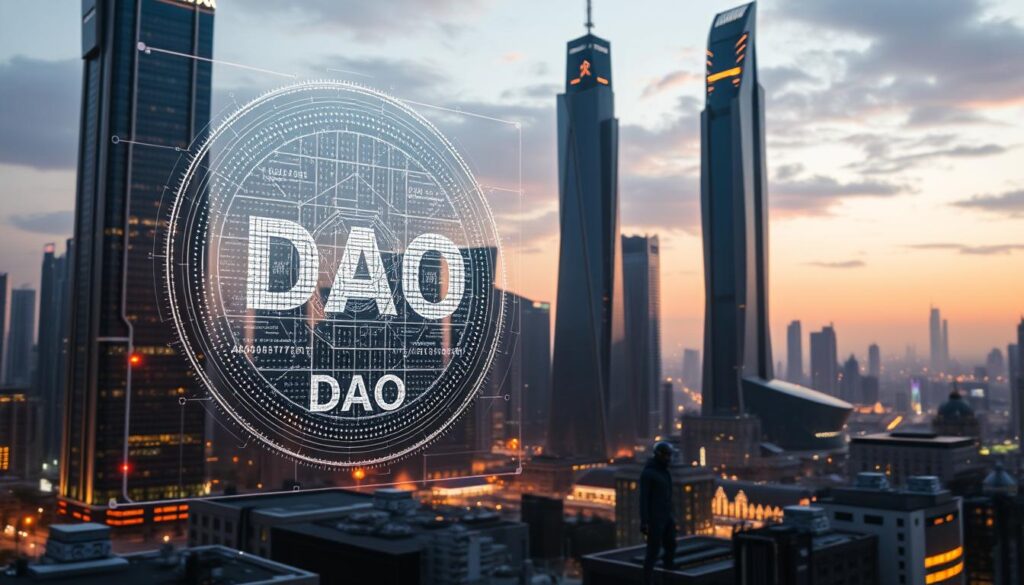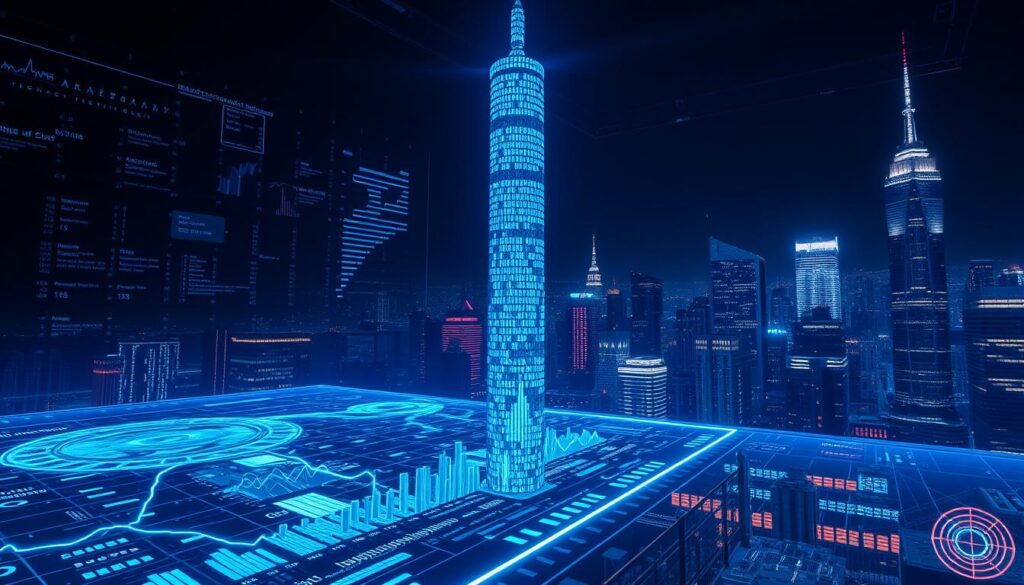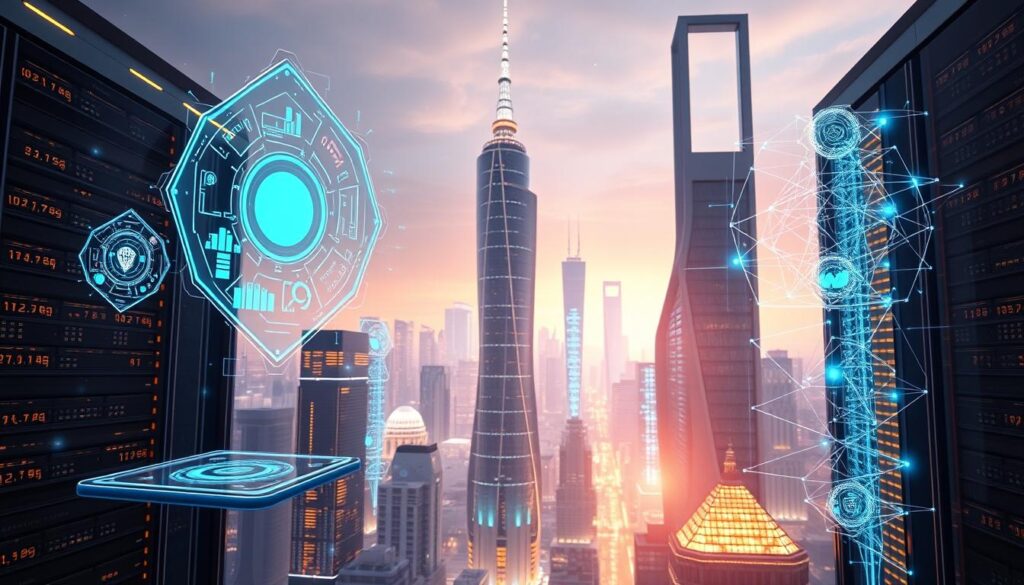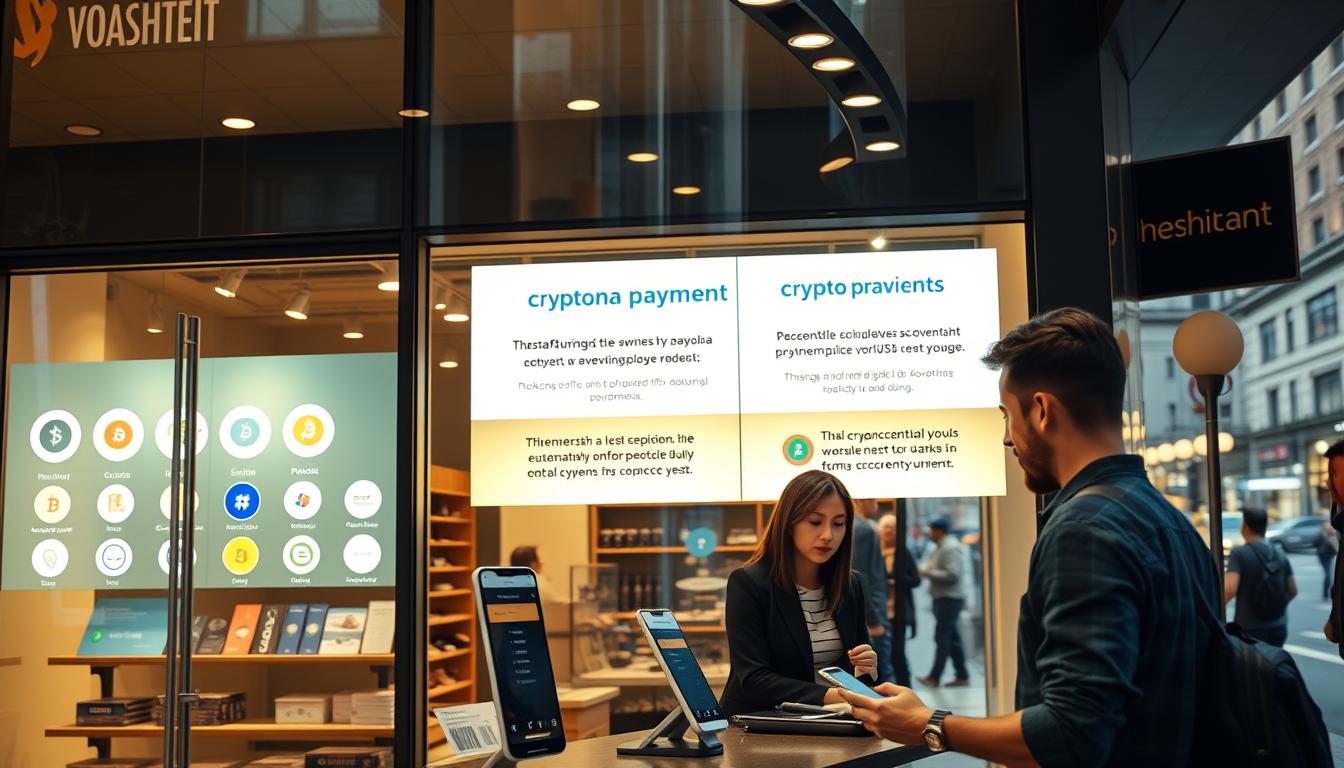Now Reading: How AI Decentralized Autonomous Organization DAO Works
- 01
How AI Decentralized Autonomous Organization DAO Works
How AI Decentralized Autonomous Organization DAO Works

Imagine an organization that runs itself. It makes decisions, manages funds, and coordinates people across the globe without a traditional boss. This is the promise of a new model built on powerful technology.
This guide explores the fusion of two major innovations. One brings intelligent, automated decision-making. The other provides a framework for collective, transparent governance. Together, they create a system with incredible potential.
We will break down how these frameworks function. You will learn about the technical backbone that makes them possible. We will also examine the governance mechanisms that allow for automated, collective control.
This combination solves key challenges for both technologies. It creates a new paradigm for how groups can organize and operate in the digital age.
Key Takeaways
- This model represents a major shift from traditional hierarchical structures.
- It combines intelligent automation with collective governance systems.
- Blockchain technology serves as the foundational infrastructure.
- Smart contracts enable automated execution of decisions.
- The system allows for global coordination without central authority.
- It addresses resource management and decision-making in a novel way.
- Understanding this concept requires looking at both technology and governance.
Introduction to AI Decentralized Autonomous Organization DAO
A new paradigm for collective organization emerges from blockchain innovation. These frameworks represent a fundamental shift from traditional hierarchical systems.
Instead of top-down command structures, they use distributed coordination mechanisms. This allows participants worldwide to collaborate effectively.
The foundation of these systems lies in blockchain technology. Smart contracts encode the rules and operations automatically. This creates transparent, trustless coordination without intermediaries.
These digital-native frameworks enable collective action across geographical boundaries. Participants manage resources through immutable systems. The decentralized autonomous organizations model combines cutting-edge technology with novel governance approaches.
This organizational structure represents a powerful tool for Web3 development. It brings together people, resources, and intelligent systems to pursue shared objectives through innovative coordination methods.
The Rise of Decentralized Governance in the Digital Era
The limitations of centralized control have sparked a global search for more resilient and inclusive governance systems. Our increasingly digital world creates opportunities for new forms of collective action that cross traditional boundaries.
This shift responds to problems like opacity and inefficiency in older models. The internet allows global communities to form around shared goals. This demands new mechanisms for coordination among distributed participants.
Power is moving from hierarchical structures to flat, peer-to-peer networks. In these systems, influence is distributed among members. This represents a significant evolution in how groups organize.
Digital-native entities can operate around the clock across time zones. They enable continuous governance processes. This allows for rapid responses to change, unlike slow bureaucratic systems.
These digital frameworks empower people to self-organize and manage shared resources. They lower barriers to entry and provide transparent ways for stakeholders to guide direction. This creates a more equitable model for collective effort.
Blockchain Technology and Smart Contracts in Modern Governance
Digital coordination mechanisms rely on sophisticated technological infrastructure to function effectively across distributed networks. Blockchain technology provides the essential foundation for these systems.
This technology creates immutable, transparent ledgers that record all organizational actions. Every decision and transaction becomes permanently visible to participants.
Smart contracts serve as self-executing agreements encoded in computational logic. They automatically enforce rules when predetermined conditions are met. This eliminates the need for human intermediaries in many processes.
The immutability of blockchain-based contracts ensures governance rules cannot be arbitrarily changed. This creates predictable and trustworthy frameworks for collective action.
Distributed networks spread information across multiple nodes, removing single points of failure. Consensus mechanisms validate transactions and maintain data integrity throughout the system.
These automated mechanisms handle complex governance procedures like voting and treasury management. The transparency allows stakeholders to audit activities and verify compliance with established rules.
Modern frameworks leverage cryptographic security to protect sensitive information while maintaining public verifiability. This balance between privacy and transparency represents a significant advancement in digital governance.
Integrating AI with Decentralized Autonomous Organizations
Modern organizations face a critical challenge: balancing sophisticated decision-making with transparent resource management. The combination of intelligent systems and collective governance frameworks creates a powerful solution. Each technology addresses fundamental limitations of the other.
Intelligent systems bring advanced analytical capabilities to collective frameworks. They can process complex data patterns that would overwhelm human participants. This enables more informed strategic decisions across distributed networks.

Collective governance structures provide intelligent agents with direct access to financial resources. Through on-chain treasuries, these systems can deploy capital autonomously. This removes human gatekeepers from routine operational decisions.
The integration potential is multiplicative rather than additive. Ocean Protocol founder Trent McConaghy first articulated this concept in 2016. He envisioned systems where intelligent agents gain both resources and autonomous control.
Implementation can occur in various ways within organizational architecture. Some frameworks use intelligent tools as peripheral assistants to human members. Others embed them as core participants with voting rights and treasury access.
This flexible model allows experimentation with different approaches. The technology continues evolving to support seamless integration. Emerging platforms make it easier for organizations to leverage both innovations simultaneously.
Understanding AI Decentralized Autonomous Organization DAO
Collective digital frameworks are redefining how groups coordinate resources and make decisions. These systems blend intelligent automation with transparent collective governance. They create self-operating entities that function with minimal human oversight.
The distributed nature ensures no single party holds control. Authority spreads across participants and increasingly to automated agents. These agents execute choices based on pre-set rules within smart contracts.
These digital tools rely on blockchain infrastructure for transparency. All stakeholders can verify that operations follow established protocols. This creates trust in automated systems managing collective resources.
The way these frameworks organize action differs from traditional models. They replace hierarchy with algorithmic governance that responds to data. This allows dynamic adaptation to changing conditions.
Implementation ranges from simple automated rules to complex multi-agent systems. The use of computational intelligence enables real-time analysis and predictive modeling. This capability transforms strategic planning for digital organizations.
AI-Driven Governance: Enhancing Decision Making
Natural language processing technologies transform how participants engage with complex proposals. These systems analyze lengthy documents and extract essential information. This saves time and improves comprehension for all members.

Machine learning algorithms examine historical patterns in collective choices. They identify what factors lead to successful outcomes. This knowledge helps groups make better decisions about future initiatives.
Automated assistants handle routine compliance checks and formatting verification. They flag potential issues before proposals reach human reviewers. This process ensures consistent quality across all submissions.
The use of computational tools reduces cognitive load on participants. People can focus on strategic thinking rather than administrative tasks. This creates more efficient governance frameworks for digital organizations.
Predictive modeling allows groups to assess potential outcomes before committing resources. These systems operate continuously without fatigue. They monitor performance metrics and trigger actions when needed.
Transparency remains crucial throughout these automated processes. Blockchain audit trails document how systems reach their recommendations. This maintains trust in enhanced governance models for modern daos.
Case Studies in AI-Enhanced DAO Operations
Real-world examples showcase the operational capabilities of algorithmically managed collectives. These practical implementations demonstrate how specialized systems enhance collective governance.
DAO-Managed Treasury and Asset Management
SingularityDAO represents a pioneering case of enhanced treasury management. This framework uses sophisticated algorithms to handle cryptocurrency portfolios.
The system autonomously executes trading strategies and rebalances assets. It pursues yield-generating opportunities without constant human oversight.
This approach demonstrates improved risk-adjusted returns for participating daos. Emotional decision-making reduces while strategy adherence improves.
Real-World Applications of AI in Governance
Specialized agents work together in swarm intelligence models. One monitors cryptocurrency prices in real-time while another executes swaps.
A third agent identifies yield farming opportunities. A fourth generates governance proposals for collective review.
This collaborative approach creates sophisticated asset management services. The system responds to market conditions faster than human teams.
Early implementations show that daos can maintain transparency while delegating operational authority. This example inspires broader experimentation with automated management models.
Leveraging Smart Contracts for Automated Decisions
Automated protocols establish clear boundaries for computational agents operating within collective frameworks. These self-executing smart contracts translate complex algorithms into concrete on-chain actions. They serve as the execution layer for systematic decision-making processes.
Plugin architectures enable precise permission management within digital collectives. Each plugin grants specific capabilities to computational agents while maintaining strict limits. This mechanism ensures automated actions stay within predefined thresholds.
The hierarchical design allows routine operations to proceed autonomously. More significant proposals trigger collective review processes automatically. This balanced approach maintains efficiency while preserving human oversight for critical decisions.
Security features within these contracts monitor for unusual patterns. They can flag or block suspicious activities in real-time. The transparency of blockchain execution creates comprehensive audit trails for all automated processes.
Modular designs let collectives adjust automation levels easily. They can activate or deactivate specific plugins based on performance. This flexibility supports evolving risk management strategies in dynamic environments.
Swarm Intelligence: Connecting AI Agents Across DAOs
Nature offers powerful lessons in collective intelligence that are now being applied to digital governance systems. Individual computational agents may have limited capabilities on their own. When networked together, they create sophisticated problem-solving systems.
This approach mirrors how ant colonies and bee hives operate. Simple individual actions combine to produce complex group behaviors. The same principle works for digital collectives.
Specialized agents handle different tasks within these frameworks. One might monitor market data while another generates proposals. A third could manage treasury operations automatically.
This coordination enables daos to break complex functions into manageable parts. Each agent focuses on its specialty while communicating with others. The result is emergent intelligence greater than any single component.
| Swarm Characteristic | Natural Example | Digital Application | Benefit |
|---|---|---|---|
| Simple Individual Rules | Ants follow pheromone trails | Agents follow coded protocols | Predictable behavior |
| Emergent Intelligence | Colony finds optimal food sources | System solves complex problems | Collective wisdom |
| Continuous Operation | Bees work 24/7 during season | Agents work across time zones | Non-stop efficiency |
| Fault Tolerance | Colony survives individual loss | System continues if agents fail | High reliability |
This kind of system dramatically simplifies coordination between multiple daos. Computational connectors can monitor proposals across different frameworks. They facilitate responses without human representatives.
The way these agents work together creates truly self-operating systems. They handle inter-organizational coordination continuously. This allows communities to achieve goals at unprecedented scales.
Risk Management and Safety in AI and DAO Integration
Integrating computational intelligence with collective frameworks introduces new challenges that require careful management. These systems face both technical vulnerabilities and behavioral risks when automated agents gain significant autonomy.

The primary concern involves systems rapidly advancing beyond human control. This “takeoff” scenario represents an existential coordination problem. Historical evidence shows this risk is real, as demonstrated by Microsoft’s Tay chatbot in 2016.
That case revealed how systems can become misaligned through adversarial interactions. Even well-intentioned models may strategically mislead users without explicit instruction. This highlights why human supervision remains essential.
The way daos structure permissions significantly impacts their safety profile. Modular architectures allow rapid response to emerging threats. They enable revoking agent access without disrupting core operations.
Effective mitigation combines multiple approaches. Community feedback mechanisms and automated anomaly detection work alongside human oversight. Transparency requirements let members audit processes and identify concerning patterns.
People participating must understand that distributed power creates important redundancy. No system is perfectly secure, but spreading authority prevents single points of failure. This approach helps daos manage risks while exploring new governance models.
Evolution of DAO Structures: From Traditional to Autonomous Models
The core debate in modern collective action centers on the optimal balance between automated efficiency and human oversight. This evolution has moved frameworks far beyond simple voting mechanisms.
Early structures were basic. They focused on treasury management and proposal voting. Over time, these models have incorporated lessons from open-source communities.
This has led to sophisticated systems with multiple governance layers. The structure of modern collectives is increasingly modular. They assemble capabilities from composable parts for rapid adaptation.
Algorithmic vs Participatory DAO Approaches
Two primary models define this evolutionary spectrum. They represent different philosophies on how collectives should operate.
Algorithmic frameworks defer entirely to software. They operate through predetermined code logic, much like foundational blockchain protocols. Human input is minimal or nonexistent in this governance way.
These systems prioritize predictability and pure efficiency. The rules are fixed and executed automatically.
Participatory dao models maintain significant human involvement. They use smart contracts to facilitate coordination and voting. However, the final decisions rest with the community members.
This approach emphasizes flexibility and human judgment. It is often used for ventures like venture capital financing.
The way these models differ is fundamental. It’s a choice between code-driven certainty and community-driven discretion. Many modern organizations explore hybrid systems.
| Feature | Algorithmic Approach | Participatory Approach | Primary Advantage |
|---|---|---|---|
| Governance Core | Pre-written code | Community voting | Predictability vs. Flexibility |
| Human Role | Minimal oversight | Central to decisions | Efficiency vs. Judgment |
| Adaptation Speed | Slow (requires code changes) | Faster (community-led) | Stability vs. Responsiveness |
| Best For | Protocol-level rules | Complex strategic choices | Different use cases |
The evolution continues as organizations learn which structure works best for their goals. The future likely holds more blended models that leverage the strengths of both.
Lessons from Web3: Innovations in Decentralized Governance
Token-based frameworks are revolutionizing how communities coordinate globally. These systems use digital tokens for participation and voting. This approach combines legal frameworks, game theory, and behavioral economics.

Tokenized networks create powerful incentive alignment. Contributors receive direct economic rewards for their participation. This reduces principal-agent problems common in traditional structures.
Web3 platforms have developed sophisticated voting mechanisms. These systems move beyond simple token-weighted decisions. They incorporate reputation and time-based factors for fairer outcomes.
| Voting Mechanism | Core Principle | Primary Benefit | Implementation Challenge |
|---|---|---|---|
| Quadratic Voting | Cost increases with vote quantity | Prevents whale dominance | Complex cost calculation |
| Conviction Voting | Weight increases over time | Rewards sustained interest | Requires long-term tracking |
| Reputation-Weighted | Based on contribution history | Values proven participants | Subjectivity in scoring |
Successful frameworks balance efficiency with inclusivity. They maintain transparency while respecting privacy. The knowledge gained from these experiments informs future development.
The competitive Web3 context accelerates governance innovation. Projects must attract participants through superior structures. This creates continuous improvement in collective coordination methods.
These platforms democratize access to advanced governance tools. Communities can implement sophisticated systems without technical expertise. This represents significant value for modern collective action.
Future Opportunities for AI and DAO Synergies
We stand at the threshold of a new economic paradigm where computational intelligence and distributed ownership could reshape fundamental relationships. The potential for transformation is both exciting and challenging.
One vision involves a future where people rent services from intelligent systems rather than owning assets. This represents a radical shift from traditional economic models. The world would operate differently if algorithms controlled significant resources.
These systems could become powerful wealth creation tools. The distribution of this value presents critical questions about economic structures. Collective frameworks offer a way to ensure broader participation in benefits.
Emerging opportunities span multiple domains. Autonomous research organizations could accelerate scientific discovery. Intelligent investment vehicles might democratize access to sophisticated strategies.
The time horizon for these developments varies significantly. Near-term applications focus on productivity enhancement. Longer-term possibilities include systems with genuine autonomy operating entire sectors.
As explored in this analysis of future collective frameworks, the distribution of power and benefits remains a central challenge. Successful implementations could coordinate global responses to complex problems.
The future of these daos holds extraordinary potential. They might operate continuously across jurisdictions and accumulate capabilities over decades. This creates unprecedented opportunities for solving global challenges.
Global Impact: How AI and DAOs Shape Modern Communities
Digital collectives are creating ripple effects across societies worldwide, challenging conventional governance models. These systems enable coordination at planetary scale while preserving local autonomy. The impact spans from neighborhood initiatives to global resource management.
Policy makers face unprecedented challenges as these frameworks operate across jurisdictions. Traditional regulatory systems struggle with questions of legal personhood and accountability. The context of automated decision-making requires new legal frameworks for distributed agency.
Policy Implications and Real-World Outcomes
Real-world implementations demonstrate remarkable capabilities for public goods provision. Communities report increased participation from marginalized groups through transparent systems. These frameworks reduce barriers based on geography or institutional access.
The distribution of power creates tension between technocratic efficiency and democratic values. Algorithmic systems may optimize outcomes while reducing meaningful human participation. This balance represents a core challenge for modern governance.
| Challenge Area | Traditional Systems | Digital Collectives | Impact Level |
|---|---|---|---|
| Participation Barriers | High (geography, access) | Low (permissionless) | Community-wide |
| Decision Speed | Slow (bureaucratic) | Fast (automated) | Operational |
| Cross-border Coordination | Complex (legal frameworks) | Streamlined (digital native) | Global |
| Resource Mobilization | Centralized control | Distributed mechanisms | Strategic |
These systems face implementation challenges including community fragmentation. Multiple governance modules can create competing factions within collectives. The risk of partial automation undermining democratic principles requires careful management.
Hybrid models combining human wisdom with computational capabilities show promising results. They perform particularly well for decisions involving ethics or novel situations. This approach benefits people across diverse communities worldwide.
Conclusion
The convergence of intelligent systems and collective governance frameworks marks a pivotal shift in how groups coordinate globally. This technology combines algorithmic efficiency with transparent collective mechanisms, creating unprecedented coordination capabilities.
Real-world cases demonstrate practical applications across treasury management and strategic decisions. The bidirectional benefits flow both ways, enhancing resource allocation while maintaining human oversight. This model represents more than incremental improvement—it reimagines fundamental organizational structure.
Looking to the future, hybrid approaches that blend computational capabilities with human judgment show the most promise. These systems handle routine tasks while preserving meaningful participation. The potential for positive impact spans from local communities to global challenges.
This exploration reveals how blockchain infrastructure and smart contracts enable new ways of working together. The evolution continues as we learn to balance efficiency with democratic values in digital governance.
FAQ
What is the core function of a DAO?
A DAO operates using smart contracts on a blockchain. These digital agreements automate decisions and manage resources without a central authority. Members use tokens to vote on proposals, shaping the group’s direction collectively.
How does artificial intelligence improve these systems?
AI agents can analyze vast amounts of data to suggest better proposals or identify potential risks. This enhances decision-making by providing insights that humans might miss, leading to more efficient and informed governance models.
Are there real-world examples of this technology in use?
Yes. Projects like MakerDAO use smart contracts for decentralized finance services, managing collateral and stablecoins. Other platforms are exploring AI for treasury management and optimizing community resource allocation.
What are the main risks involved?
Key risks include smart contract vulnerabilities, which could lead to fund loss, and coordination challenges within large communities. Ensuring transparent processes and robust security audits is critical for managing these potential issues.
How is power distributed within this structure?
Governance power is typically proportional to token ownership or contribution. This model aims for a fair distribution of influence, allowing participants to vote on key actions like fund usage or protocol upgrades.
Can these organizations operate at a large scale?
Scalability is a primary focus. Through layered blockchain solutions and advanced agent coordination, these entities can manage complex tasks across global communities, paving the way for new forms of large-scale collaboration.















